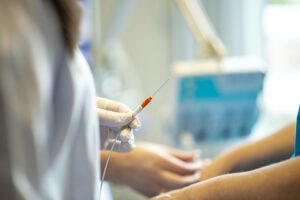Botox & Natural Ways for Youthful Skin: Safe Treatments Unveiled

Botox treatments have surged in popularity for non-invasive skin rejuvenation due to their ability t…….
In the rapidly evolving healthcare landscape, non-surgical treatments have emerged as a transformative force, offering alternative approaches to medical interventions without the risks and recovery times associated with traditional surgery. This comprehensive article delves into the multifaceted world of non-surgical treatments, exploring its definition, global impact, economic implications, technological innovations, regulatory framework, and future prospects. By examining these aspects, we aim to provide a holistic understanding of this dynamic field and its potential to shape healthcare delivery worldwide.
Non-surgical treatments, also known as minimally invasive procedures or non-invasive therapies, refer to a range of medical interventions that aim to diagnose, treat, or manage diseases without incurring the complexities and invasiveness of surgery. These treatments leverage advanced technologies and techniques to minimize tissue damage, reduce patient pain, and expedite recovery. The core components of non-surgical treatments include:
Medical Devices and Technologies: Various specialized devices such as catheters, endoscopes, ultrasound machines, and laser systems are employed to deliver treatments with precision and minimal invasion.
Invasive vs. Non-Invasive Approaches: Non-surgical treatments focus on non-invasive or minimally invasive techniques, contrasting traditional surgery’s more extensive incisions. Examples include diagnostic imaging, medication delivery, and thermal therapies.
Targeted Therapies: These treatments are tailored to specific conditions, allowing for precise interventions while minimizing systemic side effects. This targeted approach is particularly advantageous in oncology and dermatology.
The concept of non-surgical treatments has evolved over centuries, driven by medical professionals’ constant quest for less invasive procedures. Early examples include the use of bloodletting to treat various ailments in the 19th century, which, despite its limitations, was a step towards minimizing surgical intervention. The 20th century witnessed significant advancements with the introduction of diagnostic imaging technologies like X-rays and ultrasound, enabling more accurate assessments without surgery.
Today, non-surgical treatments have gained prominence due to several key factors:
Patient Preferences: Many patients prefer less invasive procedures, especially for cosmetic or pain management issues, as they offer faster recovery times and reduced scarring.
Cost-Effectiveness: Non-surgical options can be more cost-effective than surgery, leading to more accessible healthcare, particularly in resource-constrained settings.
Advancements in Technology: Technological innovations have enabled more precise and effective non-surgical treatments, addressing a broader range of medical conditions.
Global Healthcare Accessibility: These treatments play a crucial role in improving healthcare accessibility globally, especially in regions with limited access to specialized surgical facilities.
Non-surgical treatments have a profound global impact, with varying trends and applications across different regions:
North America and Europe: These regions lead in medical device innovation and adoption, driving the non-surgical market. The US, in particular, is a hub for advanced surgical alternatives, including robotic-assisted procedures and minimally invasive surgery (MIS).
Asia-Pacific: The Asia-Pacific region exhibits rapid growth in non-surgical treatments, primarily driven by increasing healthcare spending, a growing aging population, and the availability of advanced medical technologies. Countries like Japan and South Korea are at the forefront of innovations in endoscopic and robotic surgeries.
Latin America and Middle East: These regions are witnessing growing demand for non-surgical cosmetic procedures due to rising disposable incomes and a growing awareness of aesthetic treatments.
Growing Preference for Minimally Invasive Surgery (MIS): There is a global shift towards MIS, particularly in cardiovascular, orthopedic, and gynecological surgeries, due to reduced patient risks and recovery times.
Advancements in Imaging Technologies: Improved diagnostic imaging, such as high-resolution ultrasound and advanced MRI scanners, facilitate more accurate non-surgical assessments, leading to better treatment outcomes.
Telemedicine and Remote Care: The integration of telemedicine allows for remote monitoring and non-surgical interventions, making healthcare more accessible, especially in rural areas or regions with limited medical resources.
Personalized Medicine: The rise of precision medicine and targeted therapies ensures that non-surgical treatments are tailored to individual patient needs, improving efficacy and reducing side effects.
The global non-surgical treatments market is experiencing significant growth, driven by several economic factors:
| Segment | Growth Rate (2021-2028) | Market Size (2021) |
|---|---|---|
| Minimally Invasive Surgery | 7.5% | $43.6 billion |
| Diagnostic Imaging | 6.2% | $28.9 billion |
| Cosmetic Procedures | 12.3% | $15.7 billion |
| Pain Management | 8.9% | $10.5 billion |
(Source: Grand View Research)
Increasing Healthcare Spending: Governments and private entities worldwide are investing heavily in healthcare infrastructure, driving the adoption of non-surgical technologies.
Aging Population: The global aging population requires more chronic condition management, leading to increased demand for non-surgical treatments, particularly for pain relief and age-related conditions.
Technological Advancements: Innovations in medical devices and software create new market opportunities, attracting investments from venture capitalists and pharmaceutical companies.
The non-surgical treatments market attracts substantial investment due to its high growth potential and the following sectors:
Medical Device Manufacturers: Companies developing advanced surgical tools, robotic systems, and diagnostic imaging equipment receive significant funding for product research and development.
Telemedicine Platforms: Startups and established companies offering remote care solutions are gaining investor interest as telemedicine becomes integral to non-surgical healthcare delivery.
Biotechnology and Pharmaceutics: Investments in personalized medicine and targeted therapy development hold immense potential, especially in the oncology and cardiovascular sectors.
Da Vinci Surgical System, developed by Intuitive Surgical, is a robotic surgical platform that enables minimally invasive procedures across various specialties. This technology allows for enhanced precision, reduced surgical time, and improved patient recovery. Da Vinci has been used in over 6 million surgeries worldwide, demonstrating its effectiveness and safety.
Telemedicine platforms like Teladoc Health provide remote consultations and non-surgical interventions, especially beneficial for rural or underserved communities. During the COVID-19 pandemic, telemedicine usage surged as a safe alternative to in-person visits, ensuring continued access to healthcare.
High-resolution ultrasound machines, such as those produced by Sonos, enable minimally invasive imaging procedures, reducing the need for surgical biopsies and guiding non-surgical treatments with precision.
Despite its numerous advantages, non-surgical treatments also present certain challenges:
Regulatory Hurdles: Medical device approval processes vary across countries, creating delays in market access for new technologies.
Cost and Accessibility: While cost-effective in many cases, some advanced non-surgical treatments remain expensive, limiting accessibility, especially in low-income regions.
Training and Adoption: Healthcare professionals require specialized training to adopt new non-surgical techniques and technologies effectively.
Patient Selection: Proper patient selection is crucial for successful non-surgical outcomes, as not all conditions are suitable for these approaches.
Non-surgical treatments represent a significant advancement in healthcare, offering patients and healthcare providers a range of less invasive options with improved outcomes. Global trends indicate a growing acceptance and adoption of these treatments across diverse regions. As technology continues to evolve, non-surgical care will play an increasingly vital role in addressing a broader spectrum of medical conditions, shaping the future of healthcare delivery worldwide.

Botox treatments have surged in popularity for non-invasive skin rejuvenation due to their ability t…….

Botox treatments, derived from bacterial toxins, offer safe, non-surgical options for cosmetic and m…….

Botox treatments are a popular non-surgical cosmetic procedure for reducing fine lines and wrinkles…….

RF non-surgical procedures, including Botox treatments, offer cutting-edge alternatives to tradition…….

Botox treatments have become a popular non-surgical method for wrinkle reduction, offering effective…….

Botox treatments have gained popularity as a non-surgical cosmetic procedure, offering temporary mus…….

Botox treatments have emerged as a popular, non-surgical skin tightening option. By injecting botuli…….

Modern non-invasive skin smoothing techniques offer effective anti-aging solutions without surgery……..

Botox treatments have surged in popularity as a safe, non-surgical alternative for facial rejuvenati…….

Botox treatments are a popular, non-surgical anti-aging solution offering immediate and long-lasting…….